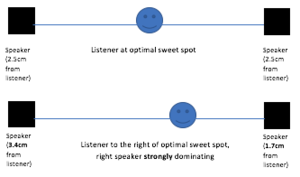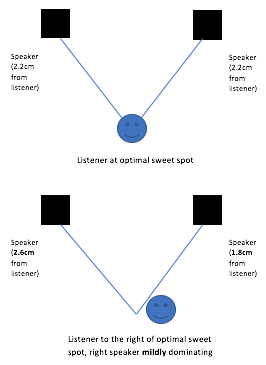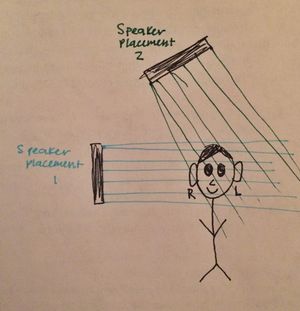Course:PHYS341/Archive/2016wTerm2/LoudSpeakerSweetSpot
Loudspeaker Sweet Spot
The loudspeaker sweet spot is the location between two loudspeakers where the sound played through the speakers is heard how it is intended to be heard, as if it were being played by a live acoustic band. Making music be perceived as if it were being played live can be achieved through headphones; left and right headphones can each play a different track that sound together to play audio to mimic the effect of live music. When listening to live, acoustic music, the sound heard by the listener is dependent on the attributes and atmospheric qualities of the area. For example, echoes, reflections and reverberations create a unique sound for the listener. Additionally, depending on the distance between the musicians and the listener, listeners can usually deduce where the sound is coming from. All of these qualities come together to give live music, especially when it’s played in a well-designed and thought-out concert hall, its rich and three-dimensional sound. Sometimes, these qualities are critical to the music, so music is recorded in a way that makes it sound like the listener is at a live performance. The process of recording sounds that are different in each ear to create a 3D effect is called binaural recording. This 3D effect can be nearly perfectly demonstrated through headphones, because different sounds are directed into each ear. However, when music is played over loudspeakers in a large area, it is difficult to maintain this effect because of crosstalk. Crosstalk is the issue that the output from both speakers can be heard with both ears, which reduces the binaural effect. [1] Two crosstalk minimization – and therefore sweet spot maximization – methods are placing the loudspeakers close together, and placing the loudspeakers at an inclined angle.
Horizontal Placement


Multiple studies have come to the conclusion that placing speakers closer together increases the size of the sweet spot.[1][2] If the speakers are closer together, there are less variations of distances between listeners and the speakers.[1] This is demonstrated in figures 1 and 2. If two loudspeakers are placed farther apart, there would be a sweet spot in the middle of the two but as a listener got slightly closer to one speaker, that speaker would dominate. If the loudspeakers are closer together, there is a larger range in which the listener can hear both signals. However, if the speakers are too close together then the binaural effect is eliminated completely and it will sound as if there is only one speaker.
Another feature that contributes to the location of the sweet spot is the frequency of the sounds coming from the loudspeakers. High frequency sound waves have short wavelengths that are directed in the direction the speaker is facing, and spread out minimally. Low frequency sound waves have long wavelengths that spread out in all directions and diffract around objects. The long-wavelength, low-frequency sounds reach a larger area and travel further. Considering the difference in frequencies, in situations where a loudspeaker set-up has both tweeters and subwoofers, the angle of the two different speakers can vary.
Overall, the exact optimal horizontal location of two speakers is dependent on a number of factors, including the frequency of the sound coming out of the speakers and the room in which they are being played. The walls of a room can reflect sound, and every room is different. Because of this, the optimal location varies, but placing the speakers at an angle in front of the listener rather than to the side has proven to be the most successful.
Vertical Placement

Studies show that the elevation of the speakers has an effect on the size of the sweet spot. With respect to head rotations, when the speakers are at a higher elevation, crosstalk is minimized and the sweet spot area is increased. The two physical phenomena that must be considered when optimizing the sweet spot size are interaural amplitude difference and interaural time delay cue.
Interaural amplitude difference occurs when one ear is closer to the sound source than the other. The ear further from the sound source is in a “sound shadow of the head” [3] and the loudness is altered depending on frequency. In the case of high frequencies, if the wavelength is smaller than the size of the head, the sound is blocked and will be much quieter to the ear on the opposite side of the head. In the case of low frequencies, if the wavelength is longer than the size of the head, the sound can sometimes diffract and become louder to the ear on the opposite side of head.[4]
Interaural time delay cue is when there is a difference in the time of arrival of the sound at the two ears because one ear is closer to the sound source than the other.[3]
If the listener turns their head when loudspeakers are played, the sound they hear is different than is intended due to these interaural effects. However, if the loudspeakers are placed above the head, when the listener turns their head there is little interaural time delay cue and little interaural amplitude difference. Therefore, optimal performance is obtained when the loudspeakers are placed at a level above the listener's head. [1]
To summarize, the optimal location of loudspeakers to maximize the sweet spot is above head-level and in front of the listener. Vertically, when the speakers are closer to being directly above the listener's head, the effects of interaural amplitude difference and interaural time delay cue are minimized and the size of the loudspeaker sweet spot is increased. If the speakers are placed too close together horizontally, the binaural effect will be eliminated. If they are too far apart, then there is a higher chance of the distance between the listener and each speaker being different, and therefore causing one of the speakers to dominate. The exact optimal horizontal placement varies, but studies consistently show that placing the speakers closer together increases the size of the sweet spot.[1][2]
References
- ↑ 1.0 1.1 1.2 1.3 1.4 Lacouture Parodi, Y., Rubak, P. (2010). Objective evaluation of the sweet spot size in spatial sound reproduction using elevated loudspeakers. The Journal of the Acoustical Society of America, 128(3), 1045–1055. Retrieved from: https://doi.org/10.1121/1.3467763
- ↑ 2.0 2.1 Bai, Mingsian R., Lee, Chih-Chung. (2006). Objective and subjective analysis of effects of listening angle on crosstalk cancellation in spatial sound reproduction. The Journal of the Acoustical Society of America, 120(4). Retrieved from: http://dx.doi.org/10.1121/1.2257986
- ↑ 3.0 3.1 White, H., White, D. (2014). Physics and Music: The Science of Musical Sound. Mineola, NY: Dover Publications
- ↑ Waltham, C. (2017). Lecture 28: Aural Perception [PowerPoint slides]. Retrieved from: http://wiki.ubc.ca/Course:PHYS341/Lectures/Lecture_30